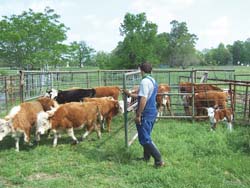 Raising miniature animals is often more of a hobby than a business. But that doesn't seem to be the case with miniature Herefords. There are many practical reasons for choosing to raise them according to Nancy Falster, who operates Falster Farm & Cattle Ranch with her husband, Karl, in Winnsboro, Texas.
Raising miniature animals is often more of a hobby than a business. But that doesn't seem to be the case with miniature Herefords. There are many practical reasons for choosing to raise them according to Nancy Falster, who operates Falster Farm & Cattle Ranch with her husband, Karl, in Winnsboro, Texas.
Cows have been bred to be bigger over the years, so she contends that miniature cattle are really the size livestock were originally. And they are a better fit for people with small acreages since it takes the same amount of land to raise two miniatures as one large beef cow. What's more, miniature cattle don't require big equipment -- a 1/2-ton pickup and 16-ft. utility trailer are adequate.
"We fence them with just two strands of electric wire and plastic fence posts," Falster says. "I can handle them by myself. When they run over you, you just get up!"
Herefords are a docile breed, she adds, and known for their marbled meat. The Falsters raise their cattle on grass.
"I believe that there's a continual growth of understanding about grass feeding over grain," she says. "You don't need a giant farm if you manage your grass."
Falster notes that mini Herefords "which weigh about 25 lbs. at birth" thrive on grass, though it takes longer to reach market weight (about 18 months) compared to grain-fed cattle.
The Falsters sell stud services, frozen embryos, semen and breeder cattle to private parties. Bulls range from 900 to 1,150 lbs. and are 46 in. tall or less. Cows weigh 500 to 850 lbs. and are 45 in. tall or less. A couple of the Falsters bulls are registered in the U.S. and in New Zealand.
This year the Falsters butchered some animals to sell. A cow dresses out to about 300 lbs.
"According to the butcher, you end up with more beef per pound of hanging weight, because there's less bone, offal and hide than on a large animal," Falster says.
With the growing popularity of petite steaks, many growers focus on high-end markets.
"We get a lot of calls from people that think miniature Herefords are a hot commodity and easy to sell. But you have to market it and work it to sell them. We spend a lot of time marketing," Falster emphasizes.
Miniature Herefords are a good choice, Falster says, for people who want their children to get involved. And, of course there are the "hobby" folks who just enjoy having miniature Herefords on their property. The good-natured animals " usually steers " make good pets that can be ridden or trained to pull a cart.
1-800-834-9665
Mini-Herefords Produce Lots Of Beef On Less Land
FARM SHOW Magazine » Mini-Herefords Produce Lots Of Beef On Less Land
Mini-Herefords Produce Lots Of Beef On Less Land
